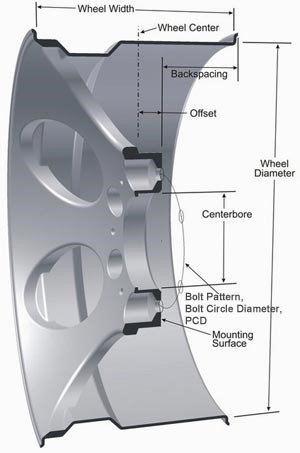
Backspacing:
The distance from the mounting surface to the back of the wheel.
Bolt Pattern, Bolt Circle Diameter:
The Bolt Pattern is the diameter of an imaginary circle that goes through the center of the bolt holes. Examples are 4×100 mm, 5×4.5 in, 6×5.5 in, 8×170 mm.
Centerbore:
The size of the hole in the back of the wheel that centers the wheel properly on the hub of the car. Many aftermarket wheels will be drilled to a larger universal size, and uses hub rings to reduce the size to match the hub on the car for perfect centering. Generally speaking, a perfect hub size match and hub rings can be optional for vehicles that use lug nuts, but are absolutely required for vehicles that use bolts such as BMW, Mercedes, and VW.
Offset:
The distance from the centerline of the wheel to the face of the mounting surface of the wheel that contacts the hub. A simple way to understand offset, is the lower the offset, the more the wheel will stick out, likewise, the higher the offset, the more the wheel will tuck. For example, and Honda Civic generally uses around a +40mm offset. So if you put a +15mm offset wheel on the car, the wheel is likely to stick out about 1 inch.
